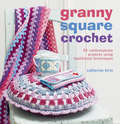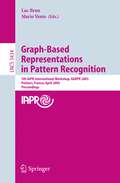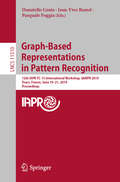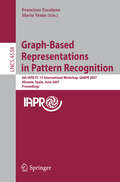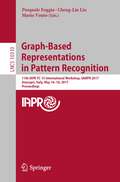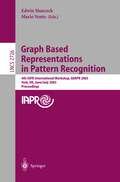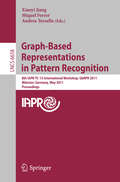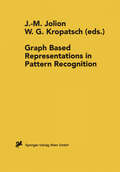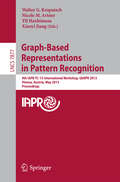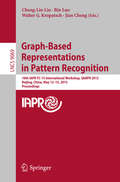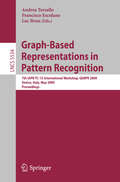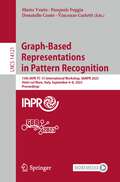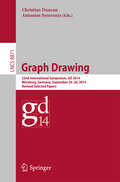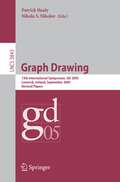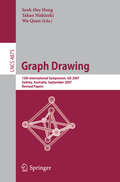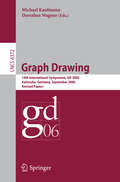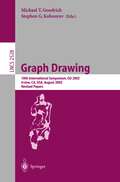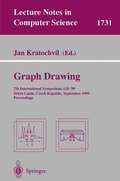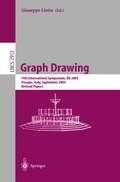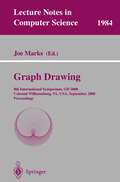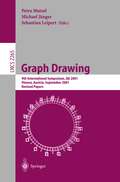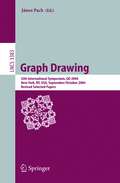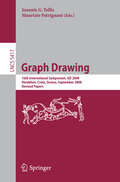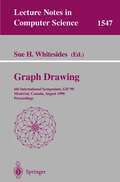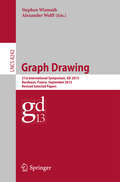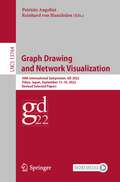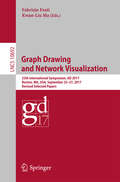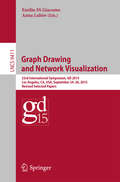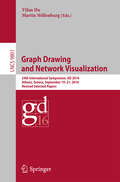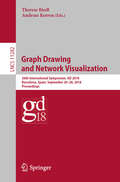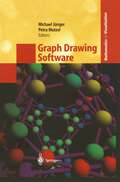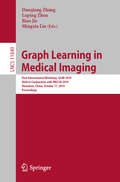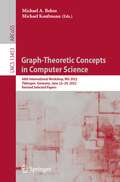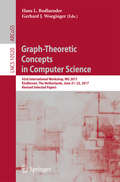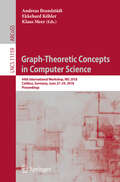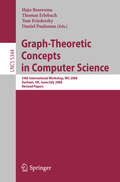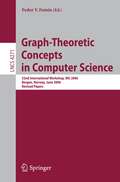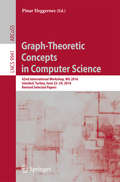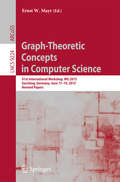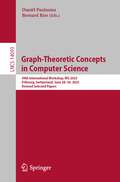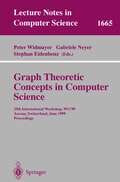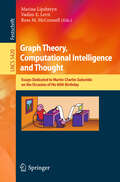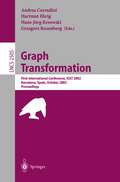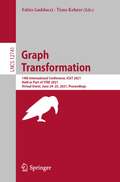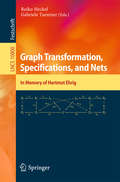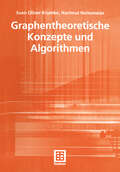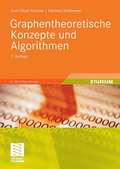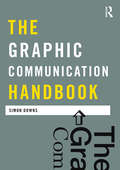- Table View
- List View
Granny Square Crochet: 35 contemporary projects using traditional techniques
by Catherine HirstMake over 35 fabulous projects, from quick and easy scarves to mug cosies. The granny square is the starting point for many people when they first learn to crochet, but as their skills progress, this versatile crochet block is often forgotten. In Granny Square Crochet , crochet teacher Catherine Hirst presents 35 projects which show how this traditional square can be updated and used in many different ways. The first chapter has over a dozen projects for the home, ranging from a blue-and-white mug cosy which can be made in less than an hour, to a stunning bed cover. There are cushions and seat covers to brighten up your living room, plus place mats, drinks coasters and a runner for your table. The second chapter has some great accessories, including gloves, scarves and bags, and even a dog coat to keep your favourite hound warm in winter. The third chapter has a great range of patterns to make as gifts for children and babies, such as crib and pram blankets, bibs, hats and toys. Each project is graded according to the level of skill required, and there is a comprehensive basic techniques chapter explaining all you need to know. Catherine Hirst was taught crochet at a young age by her grandmother and took to it immediately - she quickly learned to knit and embroider as well, and has been hand-making clothing, accessories, and gifts ever since. Her first book, Teeny Tiny Crochet , is also published by CICO Books.
Granny's Kitchen Cupboard: A Lifetime In Over 100 Objects
by John AlexanderAccumulated over many years, 'Granny', the enigmatic collector behind this book, presents a selection of quirky post-war goods, advertising and kitchen items.
Graph-Based Representations in Pattern Recognition: 5th IAPR International Workshop, GbRPR 2005, Poitiers, France, April 11-13, 2005, Proceedings (Lecture Notes in Computer Science #3434)
by Luc Brun Mario VentoMany vision problems have to deal with di?erent entities (regions, lines, line junctions, etc.) and their relationships. These entities together with their re- tionships may be encoded using graphs or hypergraphs. The structural inf- mation encoded by graphs allows computer vision algorithms to address both the features of the di?erent entities and the structural or topological relati- ships between them. Moreover, turning a computer vision problem into a graph problem allows one to access the full arsenal of graph algorithms developed in computer science. The Technical Committee (TC15, http://www.iapr.org/tcs.html) of the IAPR (International Association for Pattern Recognition) has been funded in order to federate and to encourage research work in these ?elds. Among its - tivities, TC15 encourages the organization of special graph sessions at many computer vision conferences and organizes the biennial workshop GbR. While being designed within a speci?c framework, the graph algorithms developed for computer vision and pattern recognition tasks often share constraints and goals with those developed in other research ?elds such as data mining, robotics and discrete geometry. The TC15 community is thus not closed in its research ?elds but on the contrary is open to interchanges with other groups/communities.
Graph-Based Representations in Pattern Recognition: 12th IAPR-TC-15 International Workshop, GbRPR 2019, Tours, France, June 19–21, 2019, Proceedings (Lecture Notes in Computer Science #11510)
by Donatello Conte Jean-Yves Ramel Pasquale FoggiaThis book constitutes the refereed proceedings of the 12th IAPR-TC-15 International Workshop on Graph-Based Representation in Pattern Recognition, GbRPR 2019, held in Tours, France, in June 2019.The 22 full papers included in this volume together with an invited talk were carefully reviewed and selected from 28 submissions. The papers discuss research results and applications at the intersection of pattern recognition, image analysis, and graph theory. They cover topics such as graph edit distance, graph matching, machine learning for graph problems, network and graph embedding, spectral graph problems, and parallel algorithms for graph problems.
Graph-Based Representations in Pattern Recognition: 6th IAPR-TC-15 International Workshop, GbRPR 2007, Alicante, Spain, June 11-13, 2007, Proceedings (Lecture Notes in Computer Science #4538)
by Francisco Escolano Mario VentoThis book constitutes the refereed proceedings of the 6th IAPR-TC-15 International Workshop on Graph-Based Representations in Pattern Recognition, GbRPR 2007, held in Alicante, Spain in June 2007. It covers matching, distances and measures, graph-based segmentation and image processing, graph-based clustering, graph representations, pyramids, combinatorial maps and homologies, as well as graph clustering, embedding and learning.
Graph-Based Representations in Pattern Recognition: 11th IAPR-TC-15 International Workshop, GbRPR 2017, Anacapri, Italy, May 16–18, 2017, Proceedings (Lecture Notes in Computer Science #10310)
by Pasquale Foggia Cheng-Lin Liu Mario VentoThis book constitutes the refereed proceedings of the 11th IAPR-TC-15 International Workshop on Graph-Based Representation in Pattern Recognition, GbRPR 2017, held in Anacapri, Italy, in May 2017. The 25 full papers and 2 abstracts of invited papers presented in this volume were carefully reviewed and selected from 31 submissions. The papers discuss research results and applications in the intersection of pattern recognition, image analysis, graph theory, and also the application of graphs to pattern recognition problems in other fields like computational topology, graphic recognition systems and bioinformatics.
Graph Based Representations in Pattern Recognition: 4th IAPR International Workshop, GbRPR 2003, York, UK, June 30 - July 2, 2003. Proceedings (Lecture Notes in Computer Science #2726)
by Edwin Hancock Mario VentoThe refereed proceedings of the 4th IAPR International Workshop on Graph-Based Representation in Pattern Recognition, GbRPR 2003, held in York, UK in June/July 2003. The 23 revised full papers presented were carefully reviewed and selected for inclusion in the book. The papers are organized in topical sections on data structures and representation, segmentation, graph edit distance, graph matching, matrix methods, and graph clustering.
Graph-Based Representations in Pattern Recognition: 8th IAPR-TC-15 International Workshop, GbRPR 2011, Münster, Germany, May 18-20, 2011, Proceedings (Lecture Notes in Computer Science #6658)
by Xiaoyi Jiang Miquel Ferrer Andrea TorselloThis book constitutes the refereed proceedings of the 8th IAPR-TC-15 International Workshop on Graph-Based Representations in Pattern Recognition, GbRPR 2011, held in Münster, Germany, in May 2011. The 34 revised full papers presented were carefully reviewed and selected from numerous submissions. The papers are organized in topical sections on graph-based representation and characterization, graph matching, classification, and querying, graph-based learning, graph-based segmentation, and applications.
Graph Based Representations in Pattern Recognition (Computing Supplementa #12)
by Jean-Michel Jolion Walter KropatschGraph-based representation of images is becoming a popular tool since it represents in a compact way the structure of a scene to be analyzed and allows for an easy manipulation of sub-parts or of relationships between parts. Therefore, it is widely used to control the different levels from segmentation to interpretation. The 14 papers in this volume are grouped in the following subject areas: hypergraphs, recognition and detection, matching, segmentation, implementation problems, representation.
Graph-Based Representations in Pattern Recognition: 9th IAPR-TC-15 International Workshop, GbRPR 2013, Vienna, Austria, May 15-17, 2013, Proceedings (Lecture Notes in Computer Science #7877)
by Walter Kropatsch Nicole M. Artner Yll Haxhimusa Xiaoyi JiangThis book constitutes the refereed proceedings of the 9th IAPR-TC-15 International Workshop on Graph-Based Representations in Pattern Recognition, GbRPR 2013, held in Vienna, Austria, in May 2013. The 24 papers presented in this volume were carefully reviewed and selected from 27 submissions. They are organized in topical sections named: finding subregions in graphs; graph matching; classification; graph kernels; properties of graphs; topology; graph representations, segmentation and shape; and search in graphs.
Graph-Based Representations in Pattern Recognition: 10th IAPR-TC-15 International Workshop, GbRPR 2015, Beijing, China, May 13-15, 2015. Proceedings (Lecture Notes in Computer Science #9069)
by Cheng-Lin Liu Bin Luo Walter G. Kropatsch Jian ChengThis book constitutes the refereed proceedings of the 10th IAPR-TC-15 International Workshop on Graph-Based Representations in Pattern Recognition, GbRPR 2015, held in Beijing, China, in May 2015. The 36 papers presented in this volume were carefully reviewed and selected from 53 submissions. The accepted papers cover diverse issues of graph-based methods and applications, with 7 in graph representation, 15 in graph matching, 7 in graph clustering and classification, and 7 in graph-based applications.
Graph-Based Representations in Pattern Recognition: 7th IAPR-TC-15 International Workshop, GbRPR 2009, Venice, Italy, May 26-28, 2009. Proceedings (Lecture Notes in Computer Science #5534)
by Andrea Torsello Francisco Escolano Ruiz Luc BrunGraph-Based Representations in Pattern Recognition: 13th IAPR-TC-15 International Workshop, GbRPR 2023, Vietri sul Mare, Italy, September 6–8, 2023, Proceedings (Lecture Notes in Computer Science #14121)
by Mario Vento Pasquale Foggia Donatello Conte Vincenzo CarlettiThis book constitutes the refereed proceedings of the 13th IAPR-TC-15 International Workshop on Graph-Based Representations in Pattern Recognition, GbRPR 2023, which took place in Vietri sul Mare, Italy, in September 2023.The 16 full papers included in this book were carefully reviewed and selected from 18 submissions. They were organized in topical sections on graph kernels and graph algorithms; graph neural networks; and graph-based representations and applications.
Graph Drawing: 22nd International Symposium, GD 2014, Würzburg, Germany, September 24-26, 2014, Revised Selected Papers (Lecture Notes in Computer Science #8871)
by Christian Duncan Antonios SymvonisThis book constitutes the proceedings of the 22nd International Symposium on Graph Drawing, GD 2014, held in Würzburg, Germany, in September 2014. The 41 full papers presented in this volume were carefully reviewed and selected from 72 submissions. The back matter of the book also contains 2 page poster papers presented at the conference. The contributions are organized in topical sections named: planar subgraphs; simultaneous embeddings; applications; contact representations; k-planar graphs; crossing minimization; level drawings; theory; fixed edge directions; drawing under constraints; clustered planarity; and greedy graphs.
Graph Drawing: 13 th International Symposium, GD 2005, Limerick, Ireland, September 12-14, 2005, Revised Papers (Lecture Notes in Computer Science #3843)
by Patrick Healy Nikola S. NikolovThe 13th International Symposium on Graph Drawing (GD 2005) was held in Limerick, Ireland, September 12-14, 2005. One hundred and ?fteen participants from 19 countries attended GD 2005. In response to the call for papers the Program Committee received 101 subm- sions, each detailing original research or a system demonstration. Each submission was reviewed by at least three Program Committee members; each referee’s c- ments were returned to the authors. Following extensive discussions, the comm- tee accepted 38 long papers, 3 short papers and 3 long system demos, each of which were presented during one of the conference’s 12 sessions. Eight posters were also accepted and were on display throughout the conference. Two invited speakers, Kurt Mehlhorn and George Robertson, gave fascinating talks during the conference. Prof. Mehlhorn spoke on the use of minimum cycle bases for reconstructing surfaces, while Dr. Robertson gave a perspective, past and present, on the visualization of hierarchies. As is now traditional, a graph drawing contest was held during the conference. The accompanying report, written by Stephen Kobourov, details this year’s c- test. This year a day-long workshop, organized by Seok-Hee Hong and Dorothea Wagner, was held in conjunction with the conference. A report on the “Workshop on Network Analysis and Visualization,” written by Seok-Hee Hong, is included in the proceedings.
Graph Drawing: 15th International Symposium, GD 2007, Sydney, Australia, September 24-26, 2007, Revised Papers (Lecture Notes in Computer Science #4875)
by Seok-Hee Hong Takao Nishizeki Wu QuanThis comprehensive new Springer publication constitutes the thoroughly refereed post-conference proceedings of the 15th International Symposium on Graph Drawing, GD 2007, held in Sydney, Australia, in September of 2007. The 27 full papers and 9 short papers presented together with 2 invited talks, and a report on the symposium’s graph drawing contest were carefully selected from 74 initial submissions. All of the current hot topics in graph drawing are addressed here.
Graph Drawing: 14th International Symposium, GD 2006, Karlsruhe, Germany, September 18-20, 2006, Revised Papers (Lecture Notes in Computer Science #4372)
by Michael Kaufmann Dorothea WagnerThis book constitutes the thoroughly refereed post-proceedings of the 14th International Symposium on Graph Drawing, GD 2006, held in Karlsruhe, Germany. The 33 revised full papers and 5 revised short papers presented together with 2 invited talks, 1 system demo, 2 poster papers address all current aspects in graph drawing, ranging from foundational and methodological issues to applications for various classes of graphs in a variety of fields.
Graph Drawing: 10th International Symposium, GD 2002, Irvine, CA, USA, August 26-28, 2002, Revised Papers (Lecture Notes in Computer Science #2528)
by Stephen G. Kobourov Michael T. GoodrichGraph Drawing: 7th International Symposium, GD'99, Stirin Castle, Czech Republic, September 15-19, 1999 Proceedings (Lecture Notes in Computer Science #1731)
by Jan KratochvílThe range of issues considered in graph drawing includes algorithms, graph theory, geometry, topology, order theory, graphic languages, perception, app- cations, and practical systems. Much research is motivated by applications to systems for viewing and interacting with graphs. The interaction between th- retical advances and implemented solutions is an important part of the graph drawing eld. The annually organized graph drawing symposium is a forum for researchers, practitioners, developers, and users working on all aspects of graph visualization and representations. The preceding symposia were held in M- treal (GD’98), Rome (GD’97), Berkeley (GD’96), Passau (GD’95), Princeton (GD’94), and Paris (GD’93). The Seventh International Symposium on Graph Drawing GD’99 was or- nized at Sti r n Castle, in the vicinity of Prague, Czech Republic. This baroque castle recently restored as a hotel and conference center provided a secluded place for the participants, who made good use of the working atmosphere of the conference. In total the symposium had 83 registered participants from 16 countries.
Graph Drawing: 11th International Symposium, GD 2003, Perugia, Italy, September 21-24, 2003, Revised Papers (Lecture Notes in Computer Science #2912)
by Guiseppe LiottaThe 11th International Symposium on Graph Drawing (GD 2003) was held on September 21–24, 2003, at the Universit` a degli Studi di Perugia, Perugia, Italy. GD 2003 attracted 93 participants from academic and industrial institutions in 17 countries. In response to the call for papers, the program committee received 88 re- larsubmissionsdescribingoriginalresearchand/orsystemdemonstrations.Each submission was reviewed by at least 4 program committee members and c- ments were returned to the authors. Following extensive e-mail discussions, the program committee accepted 34 long papers (12 pages each in the proceedings) and 11 short papers (6 pages each in the proceedings). Also, 6 posters (2 pages each in the proceedings) were displayed in the conference poster gallery. In addition to the 88 submissions, the program committee also received a submission of special type, one that was not competing with the others for a time slot in the conference program and that collects selected open problems in graph drawing. The aim of this paper, which was refereed with particular care andUNCHANGEDtworoundsofrevisions,istostimulatefutureresearchinthe graph drawing community. The paper presents 42 challenging open problems in di?erentareasofgraphdrawingandcontainsmorethan120references.Although the length of the paper makes it closer to a journal version than to a conference extended abstract, we decided to include it in the conference proceedings so that it could easily reach in a short time the vast majority of the graph drawing community.
Graph Drawing: 8th International Symposium, GD 2000, Colonial Williamsburg, VA, USA, September 20-23, 2000, Proceedings (Lecture Notes in Computer Science #1984)
by Joe MarksThis year’s meeting marked the Eighth International Symposium on Graph D- wing. The organizing and program committees worked hard to make this year’s symposium possible, and we were delighted that so many people came to - lonial Williamsburg, Virginia, for three days of the latest results in the eld of graph drawing. As in previous years, the review process was quite competitive. We accepted 30 out of 53 regular-length submissions, and 5 out of 15 short submissions, for a total acceptance ratio of 35 out of 68, or 51%. This year’s program featured several new developments in the eld. Four di erent approaches for handling very large graphs were presented in a session on force-directed layout. Two sessions were devoted to the latest advances in orthogonal graph drawing. And alongside the usual mix of theory and practice papers we had several contributions based on empirical studies of users and of systems. Our invited talks were given by two speakers who were new to most members of the GD community, but who work in areas that are closely related to graph drawing. Professor Colin Ware of the University of New Hampshire told us how knowledge of human visual perception is useful for the design of e ective data visualizations. And Professor David Jensen of the University of Massachusetts at Amherst talked about the process of knowledge discovery from graphs, a process that involves more than just graph drawing and visualization.
Graph Drawing: 9th International Symposium, GD 2001 Vienna, Austria, September 23-26, 2001, Revised Papers (Lecture Notes in Computer Science #2265)
by Petra Mutzel Michael Jünger Sebastian LeipertGraph Drawing: 12th International Symposium, GD 2004, New York, NY, USA, September 29-October 2, 2004, Revised Selected Papers (Lecture Notes in Computer Science #3383)
by Janos PachGraph Drawing: 16th International Symposium, GD 2008, Heraklion, Crete, Greece, September 21-24, 2008, Revised Papers (Lecture Notes in Computer Science #5417)
by Ioannis G. Tollis Maurizio PatrignaniThe 16th International Symposium on Graph Drawing (GD 2008) was held in Hersonissos, near Heraklion, Crete, Greece, September 21-24, 2008, and was attended by 91 participants from 19 countries. In response to the call for papers the Program Committee received 83 s- missions,eachdescribing originalresearchand/or a systemdemonstration.Each submissionwasreviewedbyatleastthreeProgramCommitteemembersandthe reviewer’s comments were returned to the authors. Following extensive disc- sions, the committee accepted 31 long papers and 8 short papers. In addition, 10 posters were accepted and displayed at the conference site. Each poster was granted a two-page description in the conference proceedings. Two invited speakers, Jesper Tegn´ er from Karolinska Institute (Monday) and Roberto Tamassia from Brown University (Tuesday), gave fascinating talks during the conference. Professor Tegn´ er focused on the challenges and oppor- nities posed by the discovery, analysis, and interpretation of biological networks to information visualization, while Prof. Tamassia showed how graph drawing techniques can be used as an e?ective tool in computer security and pointed to future research directions in this area. Following what is now a tradition, the 15th Annual Graph Drawing Contest was held during the conference, also including a Graph Drawing Challenge to the conference attendees. A report is included in the conference proceedings.
Graph Drawing: 6th International Symposium, GD '98 Montreal, Canada, August 13-15, 1998 Proceedings (Lecture Notes in Computer Science #1547)
by Sue H. WhitesidesGraph Drawing: 21st International Symposium, GD 2013, Bordeaux, France, September 23-25, 2013, Revised Selected Papers (Lecture Notes in Computer Science #8242)
by Stephen Wismath Alexander WolffThis book constitutes the thoroughly refereed post-conference proceedings of the 21st International Symposium on Graph Drawing, GD 2013, held in Bordeaux, France, in September 2013. The 42 revised full papers presented together with 12 revised short papers, 3 invited talks and 1 poster description were carefully reviewed and selected from 110 submissions. The papers are organized in topical sections on upward drawings, planarity, beyond planarity, geometric representations, 3D et al., universality, practical graph drawing, subgraphs, crossings, geometric graphs and geographic networks, angular restrictions, grids, curves and routes. The book also contains a short description of the graph drawing contest.
Graph Drawing and Network Visualization: 30th International Symposium, GD 2022, Tokyo, Japan, September 13–16, 2022, Revised Selected Papers (Lecture Notes in Computer Science #13764)
by Patrizio Angelini Reinhard HanxledenThis book constitutes the proceedings of the 30th International Symposium on Graph Drawing and Network Visualization, GD 2022, held in Tokyo, Japan, during September 13-16, 2022. The 25 full papers, 7 short papers, presented together with 2 invited talks, one report on graph drawing contest, and one obituary in these proceedings were carefully reviewed and selected from 70 submissions. The abstracts of 5 posters presented at the conference can be found in the back matter of the volume. The contributions were organized in topical sections as follows: properties of drawings of complete graphs; stress-based visualizations of graphs; planar and orthogonal drawings; drawings and properties of directed graphs; beyond planarity; dynamic graph visualization; linear layouts; and contact and visibility graph representations.
Graph Drawing and Network Visualization: 25th International Symposium, GD 2017, Boston, MA, USA, September 25-27, 2017, Revised Selected Papers (Lecture Notes in Computer Science #10692)
by Fabrizio Frati Kwan-Liu MaThis book constitutes revised selected papers from the 25th International Symposium on Graph Drawing and Network Visualization, GD 2017, held in Boston, MA, USA, in September 2017.The 34 full and 9 short papers presented in this volume were carefully reviewed and selected from 87 submissions. Also included in this book are 2 abstracts of keynote presentations, 16 poster abstracts, and 1 contest report. The papers are organized in topical sections named: straight-line representations; obstacles and visibility; topological graph theory; orthogonal representations and book embeddings; evaluations; tree drawings; graph layout designs; point-set embeddings; special representations; and beyond planarity.
Graph Drawing and Network Visualization: 23rd International Symposium, GD 2015, Los Angeles, CA, USA, September 24-26, 2015, Revised Selected Papers (Lecture Notes in Computer Science #9411)
by Emilio Di Giacomo Anna LubiwThis book constitutes the proceedings of the 23rd International Symposium on Graph Drawing and Network Visualization, GD 2015, held in Los Angeles, Ca, USA, in September 2015. The 35 full papers presented together with 7 short papers and 8 posters in this volume were carefully reviewed and selected from 77 submissions. Graph Drawing is concerned with the geometric representation of graphs and constitutes the algorithmic core of Network Visualization. Graph Drawing and Network Visualization are motivated by applications where it is crucial to visually analyze and interact with relational datasets. Examples of such application areas include social sciences, Internet and Web computing, information systems, computational biology, networking, VLSI circuit design, and software engineering. This year the Steering Committee of GD decided to extend the name of the conference from the "International Symposium on Graph Drawing" to the "International Symposium on Graph Drawing and Network Visualization" in order to better emphasize the dual focus of the conference on combinatorial and algorithmic aspects as well as the design of network visualization systems and interfaces.
Graph Drawing and Network Visualization: 24th International Symposium, GD 2016, Athens, Greece, September 19-21, 2016, Revised Selected Papers (Lecture Notes in Computer Science #9801)
by Yifan Hu Martin NöllenburgThis book constitutes revised selected papers from the 24th International Symposium on Graph Drawing and Network Visualization, GD 2016, held in Athens, Greece, in September 2016. The 45 papers presented in this volume were carefully reviewed and selected from 99 submissions. They were organized in topical sections named: large graphs and clutter avoidance; clustered graphs; planar graphs, layered and tree drawings; visibility representations; beyond planarity; crossing minimization and crossing numbers; topological graph theory; special graph embeddings; dynamic graphs, contest report.
Graph Drawing and Network Visualization: 26th International Symposium, GD 2018, Barcelona, Spain, September 26-28, 2018, Proceedings (Lecture Notes in Computer Science #11282)
by Therese Biedl Andreas KerrenThis book constitutes the refereed proceedings of the 26th International Symposium on Graph Drawing and Network Visualization, GD 2018, held in Barcelona, Spain, in September 2018. The 41 full papers presented in this volume were carefully reviewed and selected from 85 submissions. They were organized in topical sections named: planarity variants; upward drawings; RAC drawings; orders; crossings; crossing angles; contact representations; specialized graphs and trees; partially fixed drawings, experiments; orthogonal drawings; realizability; and miscellaneous. The book also contains one invited talk in full paper length and the Graph Drawing contest report.
Graph Drawing Software (Mathematics and Visualization)
by Michael Jünger Petra MutzelAfter an introduction to the subject area and a concise treatment of the technical foundations for the subsequent chapters, this book features 14 chapters on state-of-the-art graph drawing software systems, ranging from general "tool boxes'' to customized software for various applications. These chapters are written by leading experts: they follow a uniform scheme and can be read independently from each other. The text covers many industrial applications.
Graph Learning in Medical Imaging: First International Workshop, GLMI 2019, Held in Conjunction with MICCAI 2019, Shenzhen, China, October 17, 2019, Proceedings (Lecture Notes in Computer Science #11849)
by Daoqiang Zhang Luping Zhou Biao Jie Mingxia LiuThis book constitutes the refereed proceedings of the First International Workshop on Graph Learning in Medical Imaging, GLMI 2019, held in conjunction with MICCAI 2019 in Shenzhen, China, in October 2019. The 21 full papers presented were carefully reviewed and selected from 42 submissions. The papers focus on major trends and challenges of graph learning in medical imaging and present original work aimed to identify new cutting-edge techniques and their applications in medical imaging.
Graph-Theoretic Concepts in Computer Science: 48th International Workshop, WG 2022, Tübingen, Germany, June 22–24, 2022, Revised Selected Papers (Lecture Notes in Computer Science #13453)
by Michael A. Bekos Michael KaufmannThis LNCS 13453 constitutes the thoroughly refereed proceedings of the 48th International Workshop on Graph-Theoretic Concepts in Computer Science, WG 2022.The 32 full papers presented in this volume were carefully reviewed and selected from a total of 96 submissions. The WG 2022 workshop aims to merge theory and practice by demonstrating how concepts from Graph Theory can be applied to various areas in Computer Science, or by extracting new graph theoretic problems from applications.
Graph-Theoretic Concepts in Computer Science: 43rd International Workshop, WG 2017, Eindhoven, The Netherlands, June 21-23, 2017, Revised Selected Papers (Lecture Notes in Computer Science #10520)
by Hans L. Bodlaender Gerhard J. WoegingerThis book constitutes the revised selected papers of the 43rd International Workshop on Graph-Theoretic Concepts in Computer Science, WG 2017, held in Eindhoven, The Netherlands, in June 2017.The 31 full papers presented in this volume were carefully reviewed and selected from 71 submissions. They cover a wide range of areas, aiming at connecting theory and applications by demonstrating how graph-theoretic concepts can be applied in various areas of computer science. Another focus is on presenting recent results and on identifying and exploring promising directions of future research.
Graph-Theoretic Concepts in Computer Science: 44th International Workshop, WG 2018, Cottbus, Germany, June 27–29, 2018, Proceedings (Lecture Notes in Computer Science #11159)
by Andreas Brandstädt Ekkehard Köhler Klaus MeerThis book constitutes the revised selected papers of the 44th International Workshop on Graph-Theoretic Concepts in Computer Science, WG 2018, held in Cottbus, Germany, in June 2018. The 30 full papers presented in this volume were carefully reviewed and selected from 66 submissions. They cover a wide range of areas, aiming at connecting theory and applications by demonstrating how graph-theoretic concepts can be applied in various areas of computer science. Another focus is on presenting recent results and on identifying and exploring promising directions of future research.
Graph-Theoretic Concepts in Computer Science: 34th International Workshop, WG 2008, Durham, UK, June 30 -- July 2, 2008, Revised Papers (Lecture Notes in Computer Science #5344)
by Hajo Broersma Thomas Erlebach Tom Friedetzky Daniel PaulusmaThe 34th International Workshop on Graph-Theoretic Concepts in Computer Science (WG 2008) took place in Van Mildert College at Durham University, UK, 30 June – 2 July 2008. The approximately 80 participants came from va- ous countries all over the world, among them Australia, Brazil, Canada, Chile, Czech Republic, France, Greece, Hungary,Israel, Italy, Japan, The Netherlands, Norway, Poland, Spain, Switzerland, UK and the USA. WG 2008 continued the series of 33 previous WG conferences. Since 1975, the WG conference has taken place 21 times in Germany, four times in The Netherlands, twice in Austria as well as once in Italy, Slovakia, Switzerland, the Czech Republic, France, Norway and now in the UK. The WG conference traditionally aims at uniting theory and practice by demonstrating how graph-theoretic concepts can be applied to various areas in computer science, or by extracting new problems from applications. The goal is to present recent researchresults and to identify and exploredirections of future research. The continuing interest in the WG conferences was re?ected in the number and quality of submissions; 76 papers were submitted and in an evaluation p- cess with four reports per submission, 30 papers were accepted by the Program Committee for the conference. Due to the high number of submissions and the limited schedule of 3 days, various good papers could not be accepted. Therewereexcellent invited talks by Giuseppe Di Battista(UniversitàRoma Tre,Italy)onalgorithmicaspectsof(un)-stableroutingintheInternet,byLeszek G?sieniec (University of Liverpool, UK) on memory-e?cient graph exploration, andbyMartinGrohe(Humboldt-UniversitätzuBerlin,Germany)onalgorithmic meta theorems.
Graph-Theoretic Concepts in Computer Science: 32nd International Workshop, WG 2006, Bergen, Norway, June 22-23, 2006, Revised Papers (Lecture Notes in Computer Science #4271)
by Fedor V. FominThis book constitutes the thoroughly refereed post-proceedings of the 32nd International Workshop on Graph-Theoretic Concepts in Computer Science, WG 2006, held in Bergen, Norway in June 2006. The 30 revised full papers presented together with one invited paper were carefully selected from 91 submissions. The papers address all aspects of graph-theoretic concepts in computer science.
Graph-Theoretic Concepts in Computer Science: 42nd International Workshop, WG 2016, Istanbul, Turkey, June 22-24, 2016, Revised Selected Papers (Lecture Notes in Computer Science #9941)
by Pinar HeggernesThis book constitutes revised selected papers from the 42nd International Workshop on Graph-Theoretic Concepts in Computer Science, WG 2016, held in Istanbul, Turkey, in June 2016. The 25 papers presented in this volume were carefully reviewed and selected from 74 submissions.The WG conferences aim to connect theory and practice by demonstrating how graph-theoretic concepts can be applied to various areas of computer science and by extracting new graph problems from applications. Their goal is to present new research results and to identify and explore directions of future research.
Graph-Theoretic Concepts in Computer Science: 41st International Workshop, WG 2015, Garching, Germany, June 17-19, 2015, Revised Papers (Lecture Notes in Computer Science #9224)
by Ernst W. MayrThis book constitutes revised selected papers from the 41st International Workshop on Graph-Theoretic Concepts in Computer Science, WG 2015, held in Garching, Germany, in June 2015. The 32 papers presented in this volume were carefully reviewed and selected from 79 submissions. They were organized in topical sections named: invited talks; computational complexity; design and analysis; computational geometry; structural graph theory; graph drawing; and fixed parameter tractability.
Graph-Theoretic Concepts in Computer Science: 49th International Workshop, WG 2023, Fribourg, Switzerland, June 28–30, 2023, Revised Selected Papers (Lecture Notes in Computer Science #14093)
by Daniël Paulusma Bernard RiesThis volume constitutes the thoroughly refereed proceedings of the 49th International Workshop on Graph-Theoretic Concepts in Computer Science, WG 2023. The 33 full papers presented in this volume were carefully reviewed and selected from a total of 116 submissions. The WG 2022 workshop aims to merge theory and practice by demonstrating how concepts from graph theory can be applied to various areas in computer science, or by extracting new graph theoretic problems from applications.
Graph-Theoretic Concepts in Computer Science: 25th International Workshop, WG'99, Ascona, Switzerland, June 17-19, 1999 Proceedings (Lecture Notes in Computer Science #1665)
by Peter Widmayer Gabriele Neyer Stephan EidenbenzGraph Theory, Computational Intelligence and Thought: Essays Dedicated to Martin Charles Golumbic on the Occasion of His 60th Birthday (Lecture Notes in Computer Science #5420)
by Marina Lipshteyn Vadim E. Levit Ross McConnellMartin Charles Golumbic has been making seminal contributions to algorithmic graph theory and artificial intelligence throughout his career. He is universally admired as a long-standing pillar of the discipline of computer science. He has contributed to the development of fundamental research in artificial intelligence in the area of complexity and spatial-temporal reasoning as well as in the area of compiler optimization. Golumbic's work in graph theory led to the study of new perfect graph families such as tolerance graphs, which generalize the classical graph notions of interval graph and comparability graph. He is credited with introducing the systematic study of algorithmic aspects in intersection graph theory, and initiated research on new structured families of graphs including the edge intersection graphs of paths in trees (EPT) and trivially perfect graphs. Golumbic is currently the founder and director of the Caesarea Edmond Benjamin de Rothschild Institute for Interdisciplinary Applications of Computer Science at the University of Haifa. He also served as chairman of the Israeli Association of Artificial Intelligence (1998-2004), and founded and chaired numerous international symposia in discrete mathematics and in the foundations of artificial intelligence. This Festschrift volume, published in honor of Martin Charles Golumbic on the occasion of his 60th birthday, contains 20 papers, written by graduate students, research collaborators, and computer science colleagues, who gathered at a conference on subjects related to Martin Golumbic's manifold contributions in the field of algorithmic graph theory and artificial intelligence, held in Jerusalem, Tiberias and Haifa, Israel in September 2008.
Graph Transformation: First International Conference, ICGT 2002, Barcelona, Spain, October 7-12, 2002, Proceedings (Lecture Notes in Computer Science #2505)
by Andrea Corradini Hartmut Ehrig Hans-Jörg Kreowski Grzegorz RozenbergICGT 2002 was the ?rst International Conference on Graph Transformation following a series of six international workshops on graph grammars with - plications in computer science, held in Bad Honnef (1978), Osnabruc ¨ k (1982), Warrenton (1986), Bremen (1990), Williamsburg (1994), and Paderborn (1998). ICGT 2002 was held in Barcelona (Spain), October 7–12, 2002 under the a- pices of the European Association of Theoretical Computer Science (EATCS), the European Association of Software Science and Technology (EASST), and the IFIP Working Group 1.3, Foundations of Systems Speci?cation. The scope of the conference concerned graphical structures of various kinds (like graphs, diagrams, visual sentences and others) that are useful to describe complex structures and systems in a direct and intuitive way. These structures are often augmented by formalisms which add to the static description a further dimension, allowing for the modeling of the evolution of systems via all kinds of transformations of such graphical structures. The ?eld of Graph Transformation is concerned with the theory, applications, and implementation issues of such formalisms. The theory is strongly related to areas such as graph theory and graph - gorithms, formal language and parsing theory, the theory of concurrent and distributed systems, formal speci?cation and veri?cation, logic, and semantics.
Graph Transformation: 14th International Conference, ICGT 2021, Held as Part of STAF 2021, Virtual Event, June 24–25, 2021, Proceedings (Lecture Notes in Computer Science #12741)
by Fabio Gadducci Timo KehrerThis book constitutes the refereed proceedings of the 14th International Conference on Graph Transformation, ICGT 2021, which took place virtually during June 24-25, 2021.The 14 full papers and 2 tool papers presented in this book were carefully reviewed and selected from 26 submissions. They deal with the following topics: theoretical advances; application domains; and tool presentations.
Graph Transformation, Specifications, and Nets: In Memory of Hartmut Ehrig (Lecture Notes in Computer Science #10800)
by Reiko Heckel Gabriele TaentzerThis volume pays tribute to the scientific achievements of Hartmut Ehrig, who passed away in March 2016.The contributions represent a selection from a symposium, held in October 2016 at TU Berlin, commemorating Hartmut’ s life and work as well as other invited papers in the areas he was active in. These areas include Graph Transformation, Model Transformation, Concurrency Theory, in particular Petri Nets, Algebraic Specification, and Category Theory in Computer Science.
Graphentheoretische Konzepte und Algorithmen (XLeitfäden der Informatik)
by Sven Oliver Krumke Hartmut NoltemeierDas Buch enthält eine Einführung in graphentheoretische Grundbegriffe und Basissätze. Graphen werden als Modellierungswerkzeuge für verschiedene Anwendungen aus dem Bereich der Standortplanung, Logistik, Verkehrsplanung, des Scheduling und der Planung von Kommunikationsnetzen vorgestellt. Für die entstehenden graphentheoretischen Probleme werden effiziente Verfahren vorgestellt und rigoros analysiert. Für komplexitätstheoretisch "schwierige" Probleme enthält das Buch effiziente Näherungsverfahren, die schnell Lösungen mit beweisbarer Güte liefern.
Graphentheoretische Konzepte und Algorithmen (XLeitfäden der Informatik)
by Sven Oliver Krumke Hartmut NoltemeierDas Buch enthält eine Einführung in graphentheoretische Grundbegriffe und Basissätze. Graphen werden als Modellierungswerkzeuge für verschiedene Anwendungen aus dem Bereich der Standortplanung, Logistik, Verkehrsplanung, des Scheduling und der Planung von Kommunikationsnetzen vorgestellt. Für die entstehenden graphentheoretischen Probleme werden effiziente Verfahren vorgestellt und rigoros analysiert. Für komplexitätstheoretisch "schwierige" Probleme enthält das Buch effiziente Näherungsverfahren, die schnell Lösungen mit beweisbarer Güte liefern. Die 2. Auflage erscheint in verbesserter Form und alle bekannt gewordenen Fehler wurden korrigiert.
The Graphic Communication Handbook (Media Practice)
by Simon DownsThe Graphic Communication Handbook is a comprehensive and detailed introduction to the theories and practices of the graphics industry. It traces the history and development of graphic design, explores issues that affect the industry, examines its analysis through communications theory, explains how to do each section of the job, and advises on entry into the profession. The Graphic Communication Handbook covers all areas within the industry including pitching, understanding the client, researching a job, thumbnail drawings, developing concepts, presenting to clients, working in 2D, 3D, motion graphics and interaction graphics, situating and testing the job, getting paid, and getting the next job. The industry background, relevant theory and the law related to graphic communications are situated alongside the teaching of the practical elements. Features include: introductions that frame relevant debates case studies, examples and illustrations from a range of campaigns philosophical and technical explanations of topics and their importance.
The Graphic Communication Handbook (Media Practice)
by Simon DownsThe Graphic Communication Handbook is a comprehensive and detailed introduction to the theories and practices of the graphics industry. It traces the history and development of graphic design, explores issues that affect the industry, examines its analysis through communications theory, explains how to do each section of the job, and advises on entry into the profession. The Graphic Communication Handbook covers all areas within the industry including pitching, understanding the client, researching a job, thumbnail drawings, developing concepts, presenting to clients, working in 2D, 3D, motion graphics and interaction graphics, situating and testing the job, getting paid, and getting the next job. The industry background, relevant theory and the law related to graphic communications are situated alongside the teaching of the practical elements. Features include: introductions that frame relevant debates case studies, examples and illustrations from a range of campaigns philosophical and technical explanations of topics and their importance.
